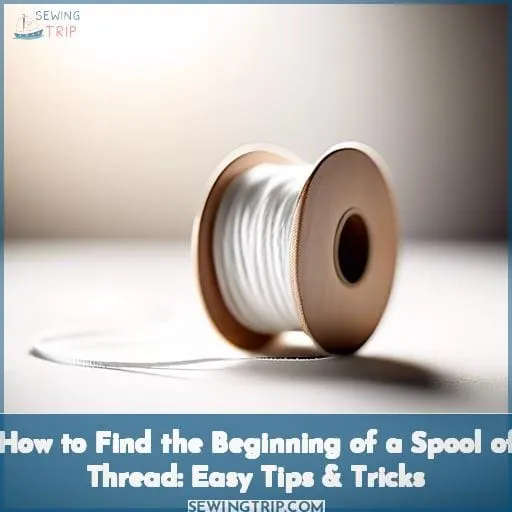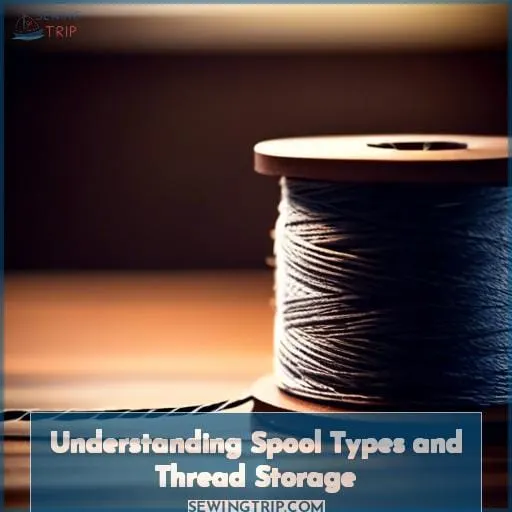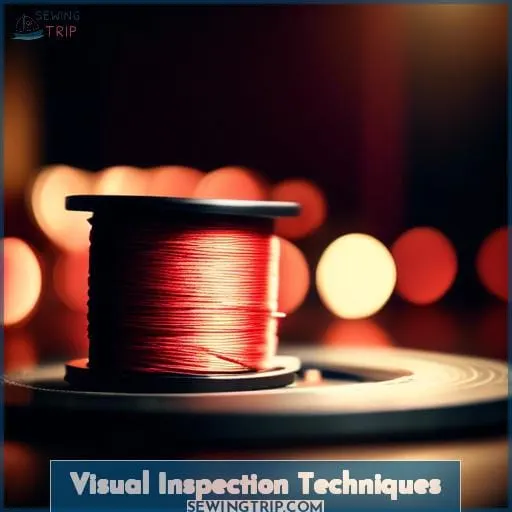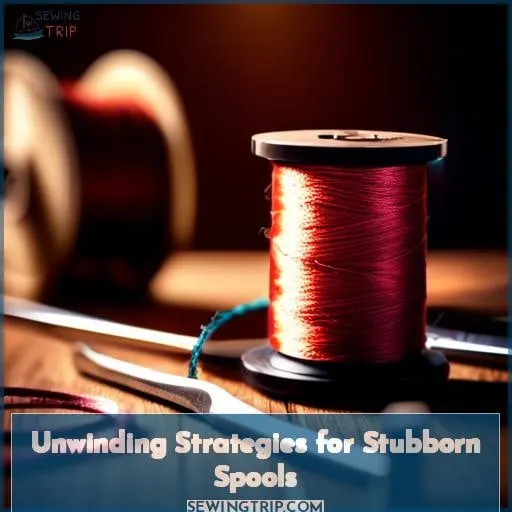This site is supported by our readers. We may earn a commission, at no cost to you, if you purchase through links.
 Imagine the frustration of a tangled mess when all you want is a smooth start to your sewing project.
Imagine the frustration of a tangled mess when all you want is a smooth start to your sewing project.
Finding the beginning of a spool of thread can feel like a puzzle. This guide offers easy tips and tricks to quickly locate the thread’s start, ensuring your creativity flows uninterrupted.
From understanding spool types to employing simple tools, you’ll master the art of preparing your thread for any task.
Table Of Contents
- Key Takeaways
- How to Find the Beginning of a Spool of Thread
- Understanding Spool Types and Thread Storage
- Visual Inspection Techniques
- Tactile Methods for Finding the Thread End
- Unwinding Strategies for Stubborn Spools
- Tools and Accessories to Aid in Locating the Thread Beginning
- Frequently Asked Questions (FAQs)
- Conclusion
Key Takeaways
- Different spool types and storage conditions, such as humidity control, can significantly affect thread tension and ease of finding the thread start.
- Visual inspection techniques, including checking the spool’s shape and looking for color shade differences or knots, can provide clues to the thread end’s location.
- Tactile methods, like running fingers along the spool surface to feel for texture changes or knots, can help in detecting the thread’s starting point.
- Utilizing tools and accessories, such as a needle threader, thread cutter, or seam ripper, can aid in locating and accessing the beginning of the thread on a spool.
How to Find the Beginning of a Spool of Thread
To find the beginning of a spool of thread, gently run your fingernail along the spool’s edge to locate a tiny slit or twist the base to reveal the thread end tucked inside. This method works for various thread brands, making it easier to start your sewing project.
Understanding Spool Types and Thread Storage
Diving into the world of sewing, you’ll quickly realize that not all spools are created equal. From wooden to plastic, each type affects thread tension and lubricity differently.
Imagine your thread as a high-performance athlete; the right storage container is its training ground. Keeping your spools in a controlled environment, away from the mischief of humidity, ensures they’re always in peak condition.
Think of humidity control as the secret sauce to maintaining the smooth glide of your thread through the eye of a needle. And remember, a well-organized storage system isn’t just about neatness—it’s your secret weapon in effortlessly pulling the start of the thread from its spool, ready to tackle any project with confidence and a bit of flair.
Visual Inspection Techniques
Alright, let’s play detective with your spool of thread. First off, give it the old eyeball test. Check the color; sometimes the end is a smidge different in shade, giving you a sneaky clue.
Now, study the spool’s shape. Is it a cone? A cylinder? The design can hint at where the elusive end might be hiding.
Feel the thread’s texture too. A rough patch could mean you’ve hit the jackpot. And knots? They’re like breadcrumbs leading you to the prize.
If you’re dealing with a tangled mess, stay cool. It’s like untangling the world’s smallest labyrinth, but hey, you’ve got this!
Tactile Methods for Finding the Thread End
Feeling a bit like a detective on a fabric caper? Let’s dive into tactile methods for finding that elusive thread end.
Start by running your fingers gently along the spool’s surface. You’re on the lookout for the subtle changes in thread texture that signal the beginning.
Knot detection is your next clue; a tiny bump might just be the start you’re after. Pay attention to friction sensing, too. The thread end often sticks out slightly, creating a noticeable drag against your fingertips.
Don’t forget to consider the fabric type and temperature difference. Sometimes, the thread feels cooler at the end.
With these tips, you’ll unravel the mystery in no time, turning frustration into triumph.
Unwinding Strategies for Stubborn Spools
After mastering the art of feeling for the thread end, you’re ready to tackle unwinding techniques for those stubborn spools that seem to mock you with their tangled threads.
Ever faced a spool that plays hard to get? It’s like it’s got its own thread tension, refusing to give up its secrets easily. The trick lies in understanding the spool design. Some spools have a small notch or slit where the thread end hides.
Gently coaxing the thread from this hiding spot can turn a frustrating experience into a victory dance.
If the thread resists, a gentle tap on the side of the spool might loosen its grip, allowing the thread to unravel smoothly.
Tools and Accessories to Aid in Locating the Thread Beginning
Diving into the quest for the elusive start of your thread? Arm yourself with a thread guide, a trusty sidekick that steers you straight to victory.
Got a bobbin that’s playing hard to get? A bobbin winder is your secret weapon, turning chaos into order.
For those pesky threads that hide like a needle in a haystack, a needle threader is your magic wand, revealing what’s hidden with a flick.
And when you’re at your wit’s end, a thread cutter slices through the confusion, offering a fresh start.
Don’t forget the seam ripper, your partner in crime, ready to undo knots and tangles.
With these tools in your arsenal, you’re set to conquer any thread challenge thrown your way.
Frequently Asked Questions (FAQs)
How do I prevent thread from tangling?
To avoid those annoying thread tangles, consider the following tips:
- Wax your thread.
- Use shorter lengths.
- Allow it to unwind occasionally.
- Knot the correct end.
- Remember, a smooth needle’s eye and high-quality thread are essential for a seamless sewing experience.
Can I use any thread for embroidery?
Diving into embroidery?
You can’t just use any old thread lying around. Like picking the right tool for a job, choosing the right thread—be it cotton, silk, or polyester—is key to a masterpiece.
What is the lifespan of sewing thread?
The lifespan of sewing thread varies. Cotton may last a few years, while high-quality polyester can last decades.
Proper storage away from light and moisture is key to extending its life.
How to measure thread thickness accurately?
To accurately measure thread thickness, grab a caliper or a pitch gauge. These tools are your best friends in the sewing game, turning the tricky task of sizing up your thread into a piece of cake.
Why does my thread keep breaking?
Thread snapping? Check needle size, bobbin issues, and thread path.
Use quality thread and ensure proper threading.
Still breaking? Might be time to switch spools or adjust tension.
Don’t let a pesky break unravel your day!
Conclusion
Surprisingly, sewers spend an average of 5 minutes untangling thread before they even start a project.
With the easy tips and tricks you’ve learned, you’ll find the beginning of a spool of thread in no time, keeping your focus on creativity, not knots.
So, grab your spool, apply these strategies, and let your sewing journey begin seamlessly.










